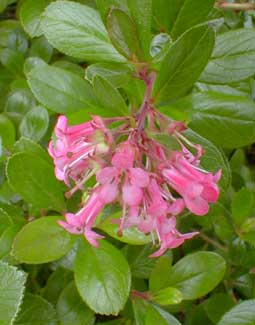
'Fradesii' or Frades' Escallonia;
aka, 'Pink Princess'
"The world is an English garden on a grand scale."
-Arthur O. Lovejoy,
1936
1936
Hybrids of Escallonia rosea & E. rubra are called Escallonia x exoniensis. The cultivar shown here is named 'Fradesii,' meaning "of the brothers," often shortened to 'Frades,' "Brothers."
This made me suppose it was named for brother plant breeders; & since escallonias are native to South America, it was my initial guess this variety was first cultivated in a monastery so became known as the brothers' escallonia.
When I made this (incorrect) speculation, I heard from the actual breeder's grandson, Don Frades, who informed me his grampa Joseph (Jose) Frades, a Portuguese immigrant, developed this hybrid in the '40s & '50s in Fremont, California, at Frades Nursery.
The nursery is no more, but members of Joseph's family are still to be encountered in & around Fremont.
"We're pretty proud to have a plant named after our family," said Don, & who wouldn't be! He adds, "There are a few remaining green thumbs in the family, though I'm not one of them. We do have the Escallonia fradesii growing in our yard, though, as do most folks on our block. It has the additional marketing name 'Pink Princess.' It can have a few bright pink flowers at almost any time of the year, including at the height of winter, but it really takes off heavy with bloom around July's end & in August.
This South American broadleaf evergreen is very adaptable in zones 8-11. Escallonia is extremely drought hardy, but can be harmed by poorly draining soil. 'Fradesii' is a bit more tolerant of damp soils than most cultivars but good drainage will always be preferred. It demands full sun on the coast but when grown inland or further south will tolerate a slight amount of shade.
It is not terribly winter hardy & can die in zones where temperatures fall to fifteen degrees F. Puget Sound is on the "low end" of its zone tolerance, but by the number of gardens that grow it, our very few days of temperatures in the teens are not enough to harm it.
Escallonias generally bloom best if occasionally watered, but in xeriscape gardens that are never watered at all it still does pretty well. 'Fradesii' grows to five or six feet tall & wide & can eventually get leggy, but if pruned each autumn when there is a slack in flowering it will remain compact.
I photographed this shrub in a friend's garden. They have a hedged row of them, plus free-standing 'Fradesii' escallonias allowed their full reach.
Judging by their several shrubs grown in two distinct manners, it's obviously very amenable to hedging or for topiary use, though it does not have as many blossoms when too often trimmed. Trimmed, it can have a very formal look, but let to have its full reach, it is much more natural & informal.
See also:
Escallonia langleyensis 'Apple Blossom'